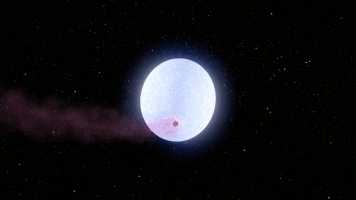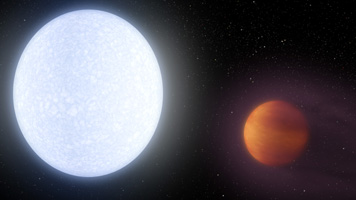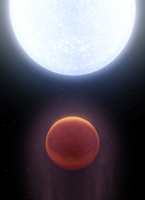
Animation |  |
| Figure 1 | Figure 2 |
Click on an individual image for larger viewThis artist's concept shows planet KELT-9b orbiting its host star, KELT-9. It is the hottest gas giant planet discovered so far.
With a dayside temperature of more than 7,800 degrees Fahrenheit (4,600 Kelvin), KELT-9b is a planet that is hotter than most stars. But its star, called KELT-9, is even hotter -- a blue A-type star that is likely unraveling the planet through evaporation.
KELT-9b is a gas giant 2.8 times more massive than Jupiter, but only half as dense. Scientists would expect the planet to have a smaller radius, but the extreme radiation from its host star has caused the planet's atmosphere to puff up like a balloon.
The planet is also unusual in that it orbits perpendicular to the spin axis of the star. That would be analogous to the planet orbiting perpendicular to the plane of our solar system. One "year" on this planet is less than two days long.
The KELT-9 star is only 300 million years old, which is young in star time. It is more than twice as large, and nearly twice as hot, as our sun. Given that the planet's atmosphere is constantly blasted with high levels of ultraviolet radiation, the planet may even be shedding a tail of evaporated planetary material like a comet.
Two still images are also available in Figure 1 and 2.
The study reporting the KELT-9 discovery was largely funded by the National Science Foundation (NSF) through an NSF CAREER Grant, NSF PAARE Grant and an NSF Graduate Research Fellowship. Additional support came from NASA via the Jet Propulsion Laboratory and the Exoplanet Exploration Program; the Harvard Future Faculty Leaders Postdoctoral Fellowship; Theodore Dunham, Jr., Grant from the Fund for Astronomical Research; and the Japan Society for the Promotion of Science.
For more information about exoplanets, visit https://exoplanets.nasa.gov.

